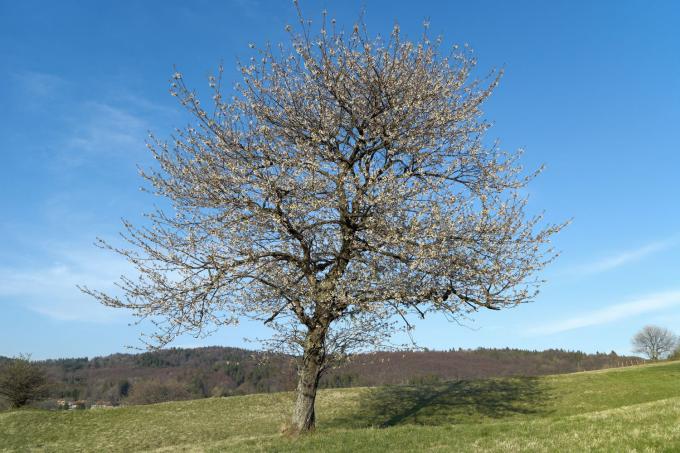The 'Sonnenwirtapfel' is an all-rounder for the home garden. With its regular yield, its resistance to diseases and its picturesque growth, it is an enrichment for orchards and country gardens in particular.

If you are looking for an apple for snacking, cooking, baking and juicing and would like to have less work with care and disease control, the 'Sonnenwirt Apple' is a good choice. The picturesque, large tree also looks good and delivers a good quantity of tasty and also quite long-lasting fruit every autumn.
"Contents"
- 'Sonnenwirtapfel': profile
- origin and history
- Appearance and taste of the 'sun host apple'
- Peculiarities in cultivation and care
- Apple variety 'Sonnenwirtapfel': harvest and use
'Sonnenwirtapfel': profile
| fruit | medium to large; Greenish-yellow basic color with a dull to dark red top colour |
| the taste | juicy, fruity with fine acidity |
| yield | medium to high and regular |
| harvest time | from September/October |
| maturity | from November on |
| shelf life | Good; can be stored until the end of February |
| growth | medium to strong; weakly branched |
| climate | low claim; Can also be cultivated at higher altitudes |
| diseases and pests | resistant to diseases and pests |
origin and history
In the town of Backnang in Baden-Württemberg, a restaurant owner known as the "Sonnenwirt" found a seedling in the garden of his home. 'Cause nearby there's an apple of the 'variety'Flamed Cardinal' grew and the varieties are very similar in appearance, it can be assumed that the seedling descended from this mother tree. However, the pollinating father variety is unknown. The variety was first described in 1932 and has since been very popular throughout southern Germany for use in orchards and private gardens. In 2017, the 'Sonnenwirtsapfel' was therefore chosen as the orchard variety of the year by the State Association for Fruit Growing, Gardening and Landscape.
Appearance and taste of the 'sun host apple'
The fruit of the apple variety 'Sonnenwirtsapfel' is medium to large, weighing 160 to 190 grams. The shape is variable from cylindrical and stalked to flattened spherical. The halves are sometimes unequally developed due to incomplete fertilization of the flower. In addition, three to five clearly visible edges are often formed on the rambur-shaped fruit. The skin has a greenish-yellow basic colour, which on the sunny side is covered flatly or in flames by a dull red to dark red top colour. The lenticels on the shell are often easily recognizable because they are surrounded by light rust. On the tree, the shell is still covered by a clearly visible, waxy cuticle, so that it appears white. The stalk is usually very thick and knobbly shortened. Under the peel there is a coarse-celled, firm and yellowish-white flesh. This is not only juicy, but also very appealing with a slightly sour, fruity taste.

Peculiarities in cultivation and care
The apple variety 'Sonnenwirtsapfel' is a clear recommendation for the home garden. It thrives in high altitudes as well as in sheltered valleys and makes only low demands on the soil and climate. Also, its fruit usually bears plentifully and regularly. The only drawback for smaller gardens is the moderate to strong growth and the only weakly branching fruit wood. This does not necessarily mean that an annual pruning is necessary, but it is useful for harvesting large and high-quality apples. If the tree is spared radical pruning into the old wood, it can reach old age, grow very large and form an evenly spherical crown that hangs low on the sides.
Most recommended is the culture as a standard or half-stem on an orchard, where the tree can develop and is only occasionally pruned.
In the home garden, the 'Sonnenwirtapfel' should be grafted onto a slow-growing rootstock such as M27 or MM106 to slow down its growth. Like all slow-growing rootstocks, however, a stable tree connection is required in this case, since the heavy crown cannot be held by the less stable root.
The 'Sonnenwirtsapfel' apple tree blooms mid-early in the year with a fairly frost-resistant blossom. In order to form its large fruits, it absolutely needs a suitable pollinator. Other mid-early flowering varieties are suitable, such as ‘Cox Orange', 'Gray Autumn Reinette', 'Idared', 'Joseph Mush' or 'Cardinal Bea‘.
Fruit yield is usually regular and medium to high. If the fruit wood is not constantly renewed through regular pruning, the fruit size can decrease.
An owner of the 'sun host apple' hardly has to fear diseases and pests, because the tree usually reliably resists them.

Apple variety 'Sonnenwirtapfel': harvest and use
Depending on the weather conditions the 'Sonnenwirtapfel' experiences at its location, the harvest can begin between September and October. Apples harvested early keep in cool natural storage – i.e. dark in boxes in the (earth) cellar – until the end of February. The good taste makes the 'Sonnenwirtsapfel' a good table apple, but it is also ideal for cider, cooking and, above all, baking.
The 'Sonnenwirtsapfel' is a versatile variety, only the size can be a problem. Unfortunately, suitable grafts with weak growth for the home garden are not always available. In addition, the rootstock is often not even identified and you buy a tree with completely unknown growth potential. We'll explain how to get around this by using your Refine apple tree yourself.
